| |
EXPLORE KASHMIR
|
|
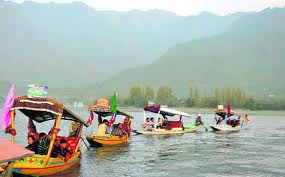 |
Srinagar Attraction
Dal Lake:
Dal Lake is one of the
most beautiful lakes of India and the second largest in the state.
Its three sides are surrounded by majestic mountains and a large
number of gardens and orchards have been laid along the shores..
Dal Lake is unique in having hundreds of houseboats, which afford
an opportunity for tourists to reside on the lake in an atmosphere
of peace and tranquility. |
|
|
|
|
|
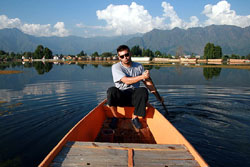 |
Nageen Lake:
Nageen lake is located just a small distance away from Dal Lake.
In fact both the water bodies are interconnected by a small water
channel. In summer time the water is pleasantly cool. The lake is
one of the best ions, which you can enjoy a captivating round of
boating. Even in the middle of the lake you can experience the
thrill of shopping. |
|
|
|
|
|
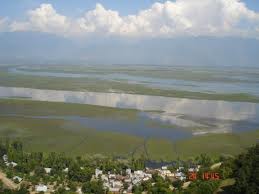 |
Wular & Manasbal Lake:
It is difficult to describe in mere words the beguiling beauty of
Wular Lake. For one, its formidable size - this is one of Asia's
largest fresh water lakes - for another, it changes character with
every few miles. The drive from Srinagar will take you to the calm
waters of Manasbal , where there is no other sound but birdsong.
Manasbal has often been described as the bird watcher's paradise,
and as your shikara glides through this mirror of tranquillity,
you will experience yet another facet of Kashmir.From Watlab, the
Wular Lake stretches away as far as the eye can see, edged by
picturesque villages around terraced breeze-rippled fields of
paddy, in a riotous burst of colour, the sheer grandeur of the
spectacular countryside at leisure. |
|
|
|
|
|
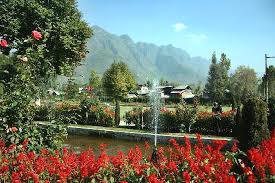 |
Shalimar Garden:
Shalimar garden was built by Mughal Emperor Jehangir in the
year 1619 AD and called it "Farah Baksh" (the delightful). Eleven
years later Zaffer Khan the Governor of Kashmir during Emperor
Shah Jahan's reign extended the garden and called it "Faiz Baksh"
(the Bountiful). The garden was graded in three sections. The
outer garden known as the Diwan-i-Aam, the central portion the
Emperor's garden called as the "Diwan-i�Khas" and the uppermost by
far the best garden was for the Empress and her ladies. The
romantic effect of numerous fountains in large tanks and central
water channel, cascades, and monumental pavilions, mighty chinars,
lush lawns laden with colour and fragrance speak volumes for the
taste of Great Mughal. |
|
|
|
|
|
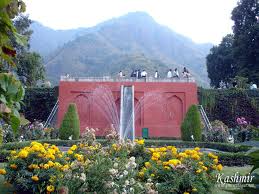 |
Nishat Garden:
Nishat garden, the garden of Delight, is the largest Mughal Garden
on Dal-Lake and was laid out by Asaf Khan, brother of Nur Jahan,
The empress of Mughal India and wife of Jahangir, in the year 1632
A.D. It is located on Dal-Lake about 2.5 Kilometers to the south
of Shalimar and commands a magnificent view in the west and with a
panoramic back drop of mountains in the East.
The garden had
originally 12 terraces. Enchanting central water channel, rippling
fountains in large tanks and channels and sparkling cascades
amidst bountiful colours, lush lawns and mighty chinars are
principal features of this pleasure garden. |
|
|
|
|
|
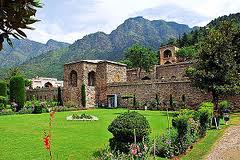 |
Pari Mahal
The name Pari Mahal appears to be a distorted version of "Peer
Mahal" built by Prince Dara Shikoh, eldest son of Emperor Shah ]ahan
in the year 1640 A.D. for his tutor Peer Mullah Shah. Once the
royal observatory, it is a seven terraced garden located on the
base of Zabarvan mountain range over-looking city of Srinagar and
Dal-Lake. The Mahal built for the meditation and summer residence
of Peer Mullah Shah is a replica of typical Mughal architecture in
garden layout, water now been restored to its glory with
captivating terraced gardens, motorable road up to the garden and
wonderful lighring effects which look marvelous and captivating at
night. |
|
|
|
|
|
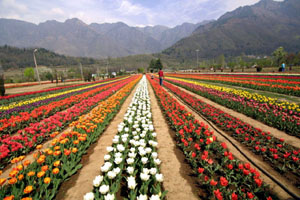 |
Tulip Garden:
Tulip garden previously named as Model Floriculture Centre, is
located at the base of Zabarwan Hills with partial fromnt view of
picturesque Dal Lake. This garden was conceived, conceptualized
and created by Mr. Gh. Nabi Azad, the then Chief Minister, J&K in
the year 2006-07. Main aim of this garden is to boost floriculture
and advance tourism in Kashmir Valley. Over 12 Lakh tulip bulbs of
68 varieties of different colours are said to be blooming here
every year |
|
|
|
|
|
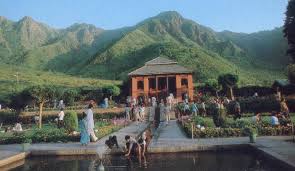 |
Cheshma Shahi:
Chashma Shahi is a beautiful garden situated at the distance of
almost eight kilometers from the city. It was a natural spring
around which a garden was developed by the brother of Nur Jahan,
the famous queen of Jahangir, the third Mughal emperor. He was so
fascinated with the surroundings that he not only decorated the
spring�s surroundings with beautiful floral plants and ornamental
trees but also roofed the spring. A reservoir was constructed
around the spring from which water gushed through canal network to
causing fountains to play day and night, creating a soothing
atmosphere during the summers. Among the Mughal gardens of Kashmir
Chashma Shahi fascinated Shahjahan, the fourth Mughal emperor, the
most owing to the fact that it haunted him with the sweet memories
of his beloved queen, Mumtaz Mahal who always accompanied him
during his visit to these gardens. |
|
|
|
|
|
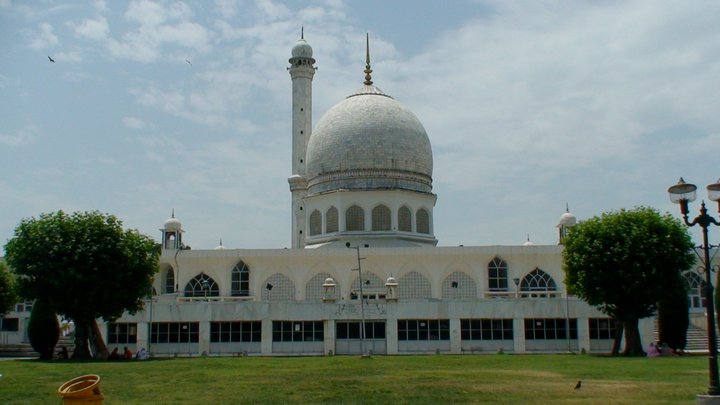 |
Hazratbal:
The Hazratbal Mosque is located in a village of the same name on
the banks of the Dal. Its pristine white marble elegance is
reflected in the waters of the lake. Hazratbal's special
significance is derived from the fact that it houses a hair of the
prophet Muhammad. This is displayed to the public on religious
occasions, usually accompanied by fairs. Apart from these
occasions, Friday prayers are offered at Hazratbal and attended by
throngs of people. Hazratbal is remarkable for being the only
domed mosque in Srinagar; the others having distinct pagoda like
roofs. The shrine � mosque complex is situated on the western
shore of the DalLake opposite Nishat Bagh and commands a grand
view of the lake and the mountain beyond.
|
|
|
|
|
|
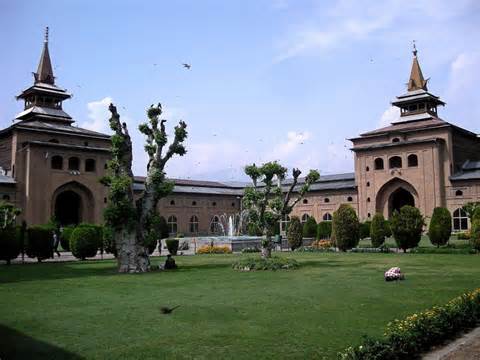 |
Jama Masjid
The Jama Masjid at Nowhatta, in the heart of the old city, is the
other important mosque in Srinagar at which thousands of people
congregate for the Friday prayers. Of imposing proportions, the
mosque is built around a courtyard and is supported by 370 wooden
pillars. The hushed quiet of the mosque counterpoints the bustle
of the old bazaars surrounding it. Originally built by Sultan
Sikandar in 1400 AD, and enlarged by his son, Zain-ul- Abidin, it
is a typical example of Indo-Saracenic architecture. Destroyed
thrice by fire and rebuilt each time, the mosque, as it now
stands, was repaired during the reign of Maharaja Pratap Singh |
|
|
|
|
|
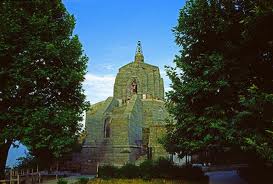 |
Shanakaracharya Temple:
The sacred temple of Shankaracharya occupies the top of the The
sacred temple of Shankaracharya occupies the top of the hills
known as Takht-I-Sulaiman in the south-east of Srinagar. The site
dates back to 250BC. The philosopher Shankaracharya stayed at this
place when he visited Kashmir ten centuries ago to revive Sanatan
Dharma |
|
|
|
|
|
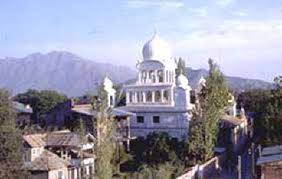 |
Chatti Padshahi Gurudwara:
The sixth Sikh guru travelled through Kashmir, stopping to preach
occasionally. A gurudwara has been built at the exact site of each
of these halts. The most important one among these is Chhatti
Padshahi gurudwara, situated near the Kathi Darwaza, in Rainawari,
Srinagar, which is held in great reverence by devotees of all
faiths |
|
|
|
|
|
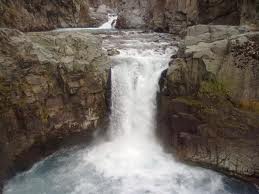 |
Harwan Buddhist Ruins:
Harwan Buddhist Ruins date back to 300 AD ,as recorded in the
chronicles, and is situated in North-West of Kashmir from eastern
side of Shalimar Mughal Garden. The ruins are famous for Kushan
period civilization. These ruins were discovered after excavation
in the first quarter of 20th Century. The position of the
excavated site reveals that the settlement structures in steps.
These ruins are not only unique in India but whole of the World
where the habitat and living conditions of Kushan period people
are seen. Henrich, an European writer, has stated that Nag Arjun
the Budhist was born in the era of Kanishk who had stationed at
Harwan. The ancient name of Harwan was Shadara-hadwan meaning
woods of six saints. On the tiles discovered from the site the
remnants of early civilization are evident. Properly shaped and
backed tiles depict the images of such people which look similar
to the people of Yarkand or Kashgar and some people are seen
wearing Turkish caps and trousers. Two springs are seen closeby
which would have been used for drinking water purpose. |
|
|
|
|
|
|
Pahalgam - Valley of
Shepherds
|
|
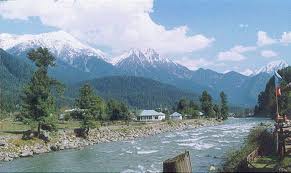 |
Pahalgam is located in the western part of the state of Jammu and
Kashmir, in the northern region of India. Situated at an altitude
of 2130 meters above sea level and positioned beside the Liddar
River, in the Liddar valley, Pahalgam is at a distance of 95 km
east of Srinagar. Pahalgam is known for the crystal clear waters
of River Lidder which is just before the entry into Pahalgam and
is an ideal spot for trekking, picnics and pony rides. Pahalgam is
adorned with lush greenery and tall pine trees. Pony rides take
you around this whole place. The picturesque location of this
place also makes it an ideal spot for movie shootings. Pahalgam is
also the starting point to take you to Pilgrimage shrines of
Amarnath Caves, which is said to be the abode of Lord Shiva. Every
year in July-Aug thousands of Pilgrims approach the caves through
here.The Valley of Shepherds as it is called, the mystic land of
Pahalgam soaked in the morning dew, looks afresh and is protected
by fir and snow capped peaks that forms an ideal destination for
the trekking aficionados. A plethora of mountains and glaciers, it
offers breathtaking views of the valleys and the surrounding area.
In short Pahalgam is rightly called the Jewel of the Liddar
Valley. |
|
|
|
|
|
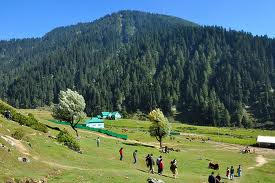 |
Aru village & valley:
Aru is a small village which forms the first step to the Kolahoi
trek. Situated at the height of 12,729 feet, it lies at a distance
of 14 km�s from Pahalgam. The Kolahoi Glacier is 36 Kms from
Pahalgam. Tarsar Lake nearby is a beautiful lake, 35 kms ahead. |
|
|
|
|
|
 |
Baisaran Meadow:
Baisaran lies at a soaring height of 2438 metres above sea level.
It is situated at a distance of 5 km�s from Pahalgam and is
densely covered with pine forests and snow clad mountains. 11 km�s
from Baisaran is the Tulian Lake, placed at an elevation of 3353
metres above the sea level. The region is blanketed by snow for
most of the time.
Mamaleshwara Temple:
Mamaleshwara is a small Shiva temple only a km or so downstream
from Pahalgam. It is thought to date from the reign of king
Jayasima and was built early in the 12th century, or even earlier. |
|
|
|
|
|
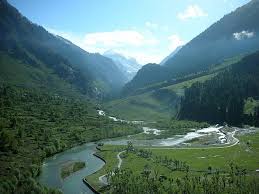 |
Betaab Valley
Enroute to Amarnath, the Betaab valley has got its name from a
Hindi Indian hit movie �BETAAB�. The film was picturised in this
beautiful valley. Located at an altitude of 2530 meters above the
sea level, this picturesque valley has all that which can attract
you to its beauty.
The eye catching sapphire like waters, the green fields, the
meadows (The �Deodar trees*�) add to the charming beauty of this
heavenly valley. |
|
|
|
|
|
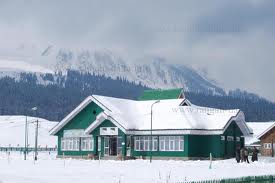
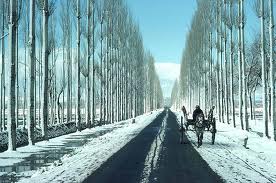 |
Gulmarg - Land of the Snows
Gulmarg�s legendry beauty, prime location and proximity to
Srinagar naturally make it one of the premier hill resorts in the
country. Originally called Gaurimarg by shepherds, its present
name was given in the 16th century by Sultan Yusuf Shah, who was
inspired by the sight of its grassy slopes emblazoned with wild
flowers. Gulmarg was a favorite haunt of Emperor Jehangir, who
once collected 21 different varieties of flowers from here. From
Gulmarg a picturesque view of the Himalayas is visible from each
and every corner of Gulmarg.
The sight of the snow capped peaks,
glaciers and fir woods in Gulmarg leave you speechless at the very
first glimpse. The drive to Gulmarg takes around 2-3 hrs by road
and is located at a height of 2650 meters above sea level. The
journey to Gulmarg is fascinating as it gives a pretty view of
flat expanses of rice fields interspersed with small hamlets, and
rigid avenues of poplar. Depending on the season, nature�s colors
could be translucent green in spring, summer�s rich emerald or
autumns golden hues, when scarlet chillies festoon windows of
village homes. After Tangmarg, the climb to Gulmarg begins through
fir-covered hillsides. At one point, known simply as View Point,
travelers generally stop their vehicles for a few minutes and look
out a spectacle of snow � covered mountains almost within touching
distance. |
|
|
|
|
|
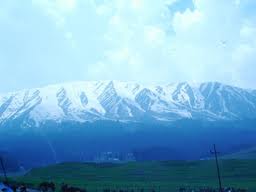 |
Khilanmarg
This smaller valley is about a 6-km walk from the Gulmarg. The
meadow, carpeted with flowers in the spring, is the site for
Gulmarg�s winter ski runs and offers a fine view of the
surrounding peaks and over the Kashmir Valley.
It�s a 600-metre
ascent from Gulmarg to Khilanmarg and during the early spring, as
the snow melts, it can be a very muddy hour�s climb up the hill.
The effort is rewarded, if it�s clear, with a sweeping view of the
great Himalayas from Nanga Parbat to the twin 7,100-metre peaks of
Nun and Kun to the southeast |
|
|
|
|
|
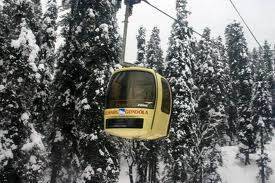 |
Mount Apharwat and Gulmarg Gondola:
Gulmarg boasts Asia's highest and longest cable car project, the
Gulmarg Gondola. The two-stage ropeway ferries about 600 people
per hour to and from Kongdoori Mountain, a shoulder of nearby
Afarwat Peak (4,200 m (13,780 ft)). The first stage transfers from
the Gulmarg resort at 2,600 m (8,530 ft) to Kongdoori Station in
the bowl-shaped Kongdori valley.
The second stage of the ropeway,
which has 36 cabins and 18 towers, takes skiers to a height of
3,747 m (12,293 ft) on Kongdoori Mountain, a shoulder of nearby
Afarwat Peak. |
|
|
|
|
|
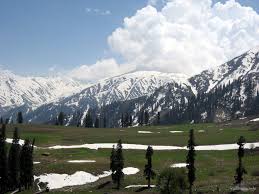 |
Alpather Lake
Beyond Khilanmarg, 13-km from Gulmarg at the foot of the twin 4,
511 metre Apharwat peaks, this lake is frozen until mid-June and
even later in the year one can see lumps of ice floating in its
cold waters. The walk from Gulmarg follows a well-graded Pony
track over the 3, 810 metre Apharwat ridge, separating it from
Khilanmarg, and then up the valley to the lake at 3,843 metres.
The more adventurous trekkers can climb straight up the
boulder-strewn slope of the ridge and descend the other side to
the path. For horse riding aficionados, Alpather Lake makes an
exciting day's excursion, starting early morning and returning
late evening. |
|
|
|
|
|
|
|
Yusmarg - The Sacred Valley
|
|
 |
Yusmarg is a small meadow set in the heart of mountains to the
south-west of Srinagar. It is an ideal picnic spot and the Nilnag
Lake can be visited from here. A two hour drive from Srinagar ( 47
kms ) will take you to acres upon acres of grassy meadow ringed by
forests of pine, and towering beyond them, awesome and majestic
snow clad mountains. Yusmarg has several important mountain peaks
to boast and the most famous amongst them are Tatta Kutti and Sang
Safed. Here in Yusmarg are walks of every sort - a leisurely amble
along flower-strewn meadows or away to where a mighty river froths
and crashes its way over rocks, its mild white foam earning it the
name of Dudh Ganga. The word �Yus� is said to be the short form of
Youza or Jesus Christ (Peace Be Upon Him) who according to a
popular belief is said to have passed though this valley while
traveling to Kashmir. |
|
|
|
|
|
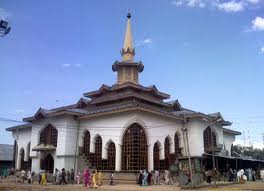 |
Tomb of Sheikh Noor-ud-din-Noorani
The tomb of Alamdar-e-Kashmir is situated 28 Kms in southwest of
Srinagar at Chrar-e- Sharif in Budgam District. The shrine on the
burial site was constructed by the then ruler of Kashmir Zain ul
Abideen. Sheikh Noor-ud-din was born in Kaimoh and his ancestors
belonged to Kishtwar. He was a pious soul and travelled throughout
Kashmir to spread the message of his religion. He meditated for 12
years inside a cave. Four centuries after his death Afghan
governor Atta Mohd. Khan issued coins in his name. The shrine
alongwith Khanqah was gutted in a devatating fire in 1995. A new
shrine is planned to be constructed in its place. |
|
|
|
|
|
|
|
Sonamarg - The Golden Land |
|
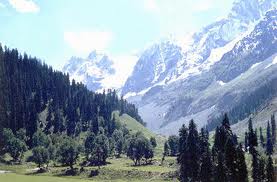
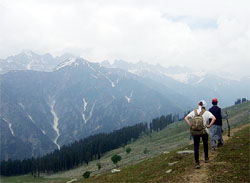 |
Sonamarg literally meaning � The Meadow of Gold� lies in the heart
of a beautiful valley carved by the river Sindh. At a magical
height of 3000 meters, the beautiful mountain resort is surrounded
by towering mountains that glow once the sun sets its eyes upon
them. Rich forests of silver, intermingled with Sycamore and
fringed on their upper borders with silver birch clothe the
mountain sides Sonamarg boasts of colorful valleys with grand
rocky cliffs and white glaciers. Situated 80 km�s northeast of
Srinagar, the road that runs to Sonamarg is the beginning of an
enchanted journey into a natural wonderland.
The road initiates
winds under the shadow of the mountains. The journey to Sonamarg
passes through peaceful pastoral land with the picturesque snow
clad Harmukh range etched against the deep blue of the Himalayan
sky. En route Sonamarg, gypsies with their cattle, ponies,
buffaloes, sheep's and goats are seen. Mighty mountains of up to
5300 metres, Thajiwas glaciers being its outstanding feature,
surround Sonamarg. Thajiwas, pine shaded, with gushing mountain
streams. Silver waterfalls and the Thajiwas glacier form a
sparkling contrast to the green meadowland. It provides a
challenging climb. Sonamarg is a wonderful destination for an
intrepid traveler, who is looking for exciting places known for
their adventure sports. Apart from valleys, the Sonamarg region
also boasts of high altitude lakes only reached via trekking
trails. |
|
|
|
|
|
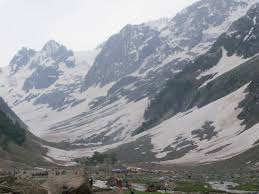 |
Thajwass Glacier:
One of the most popular short walks from Sonamarg and a major
attraction during the summer months is the 4-km route to Thajiwas,
a small valley at the foot of the Sonamarg glacier. A path leads
up to the Shakhdar hill, overlooking the glacier from the
northeast. It is dangerous to climb the steep slope leading up to
the glacier. Ponies can be hired for the trip up to Thajiwas
glacier. Often in early summer one will meet groups of Gujar
passing through Sonamarg on their way to the alpine meadows for
the summer.
|
|
|
|
|
|
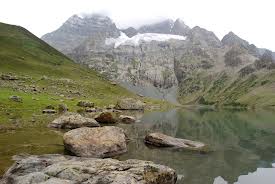 |
Gangabal Lake:
The famous Gangabal lake can be reached after a 5 day trek in the
upper reaches of the Sonamarg area. En-route to Gangabal, you can
take a fascinating trip across the Vishensar Lake (3680m) and
Gadsar Lake (3900m) through steep climbs followed by a rapid
descent, whereafter the magical Gadsar Lake appears, mostly full
of broken glacier masses. A trek of 17 km via Satsar Lake, 3600 m,
passes through Gangabal valley, where the view of Harmukh Peak is
breathtaking. A few kilometers walk will take you to Gangabal Lake
3570 m at the foot of Harmukh. A plain campsite amidst the valley
is an unforgettable experience. From Gangabal, a 17 km descend
leads to Naranag ruins. 5 km�s further down is Wangat 2050 m, from
where a metal road leads back to Sonmarg via Kangan and to
Srinagar. |
|
|
|
|
|
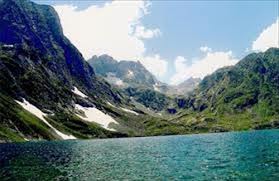 |
Bishensar and Krishensar Lakes:
There is a lake in every corner of the Himalayas and there is many
at Sonamarg also. The trail proceeds from Sonamarg to Bisansar
Lake via Nichinai Pass. Crossing the river at Nichinai Pass stands
the Bisansar Lake at an altitude of 4, 084m, with its its lovely
natural beauty. Beside the lake is the Krishnasagar Lake at an
altitude of 3,801m, popular for Trout fishing. |
|
|
|
|
|
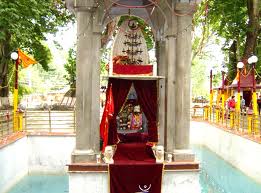 |
Khir-Bhawani
The Goddess Ragnya Devi is symbolised as a sacred spring at Tula
Mula village, 27 kms from Srinagar. Within the spring is a small
marble temple. The devotees of the goddess fast and gather here on
the eighth day of the full moon in the month of May when,
according to belief, the goddess changes the colour of the
spring's waters.
The temple-spring complex is affectionately known
as Kheer Bhawani because of the thousands of devotees who offer
milk and 'kheer' to the sacred spring, which magically changes
colours to warn of disaster. |
|
|
|
|
|
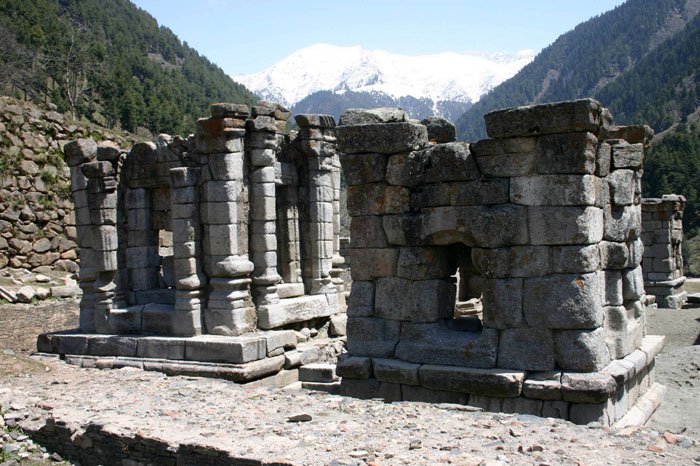 |
Naranag � Temple Complex:
The Valley of Kashmir is known not only for its lush green
meadows, snow-capped mountains but also for its historical and
religious places. There is a temple complex called Nara Nag which
evokes awe and is a devotee's delight. According to the traditions
the water of the spring comes from the Gangabal Lake, as the
spring is located at the foot of the Bhutsher or Bhuteshwara, a
spur of the Haramukha peaks. There are two groups of temples
situated at a distance of about 100 yards from each other. The
small tank with perennial water of Nara Nag has refreshing,
digestive properties. At a further distance there is a temple
dedicated to Bhairva. The western group identified with the temple
is dedicated to Lord Siva. Lalitaditya Muktapida eighth century
King of Kashmir erected a temple of Lord Shiva here. The King
Avantivarman paid a visit and donated a pedestal with a silver
conduct for bathing at Bhutsher. The temple of Naranag suffered many misfortunes as mentioned in
Khalhana's Rajatarangani during the reign of Sangramaraja (11th
century). The temple- was plundered by Bhandesvara, a Minister of
the King. For the period of the reign of Uchchala (12th century) a
conflagration caused much damage to the building and during the
reign of Jayasimha Hayavadava(12th century), a rebel minister also
attacked these temples. Nara Nag is the base camp of the Gangabal
Lake' it takes 8-10 hour on foot or on horse back to reach the
lake. |
|
|
|
|
|
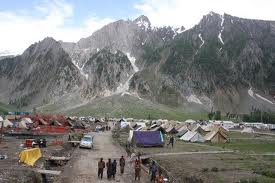 |
Baltal
Situated at a distance of 15 km�s from Sonamarg is a side valley
famous for its annual pilgrimage base to Amarnath Caves. The
meandering trek of 14 km�s starts from here and is an option for
those travelers looking for a short holiday and pilgrimage
together.
Kullan Village:
This tiny village is located just 16 kilometers below Sonamarg and
is famous for its only Four star hotel and a royal Swiss camp
located here. Apart from the calmness of this area, The village
offers quite hill tours and village walks and also has a small
river running past which becomes an anglers paradise as it boasts
of the famous trout fish. This place is an ideal base for those
who wish to relax in the cool atmosphere as well as take a holy
pilgrimage to the annual Amarnath Yatra. |
|
|
|










